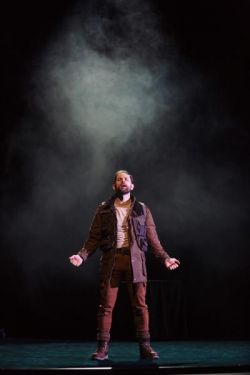Othello
This is a powerful Othello with three exceptional performances at the heart. Yalin Ozucelik’s Iago and Elizabeth Nabben’s Desdemona were excellent, but Ray Chong Nee was remarkable. His anger and anguish are utterly real, and he was visibly shaken at the curtain call.
The pre-interval half was dominated by Ozucelik’s Iago, whose character was mirrored in the movement on stage. Iago changed depending on his audience, from obsequious faux friend to his quarries to gleeful psychopath when alone. This Iago was captivating, given to sharp, jerky gestures. That choppiness informed the staging and blocking, which was energetic, with rapid mood swings and a cinematic quality with use of slow motion and perspective changes that mimicked camera movement. The effect was sometimes jarring, particularly I found myself irritated by the constant movement of a long wheeled table. In the main the frenetic pace worked to create an intense, claustrophobic mood. The drunken brawl scene alternated slow motion in short bursts with real time action cued with changing sound effects, creating a mesmerising build of drama and violence.
 After interval, Iago and his mood swings slipped into the background. From here on, Ray Chong Nee’s Othello and Elizabeth Nabben’s Desdemona take over the mood and movement, a gradual squeeze of alternating anger and dread, leading to some exquisitely beautiful moments, notably as Emilia helps Desdemona undress for bed. Desdemona knows precisely what will happen but is trapped by her role as a wife. The cold white lights fade until only one floor light is left. It’s a moment of intimacy and abject terror, a vulnerable, tiny figure singing plaintively in the gloom. Later, her bundled sleeping form behind a curtain of sheer fabric is a picture of classical beauty.
After interval, Iago and his mood swings slipped into the background. From here on, Ray Chong Nee’s Othello and Elizabeth Nabben’s Desdemona take over the mood and movement, a gradual squeeze of alternating anger and dread, leading to some exquisitely beautiful moments, notably as Emilia helps Desdemona undress for bed. Desdemona knows precisely what will happen but is trapped by her role as a wife. The cold white lights fade until only one floor light is left. It’s a moment of intimacy and abject terror, a vulnerable, tiny figure singing plaintively in the gloom. Later, her bundled sleeping form behind a curtain of sheer fabric is a picture of classical beauty.
Chong Nee’s Othello balanced pure rage with tight control. It’s as though resentment against every racist slight Othello has shrugged off finally erupts in the one mindless violent act.
Apart from the striking depth of the leads, what struck me was the breathtaking imagery and the sense of foreboding which builds right from the start. Using a palette that seems to be drawn from 1940s printing, there’s very little warmth in the lighting of mainly green, blue or harsh white, or the set, five huge pillars of mottled green velvet which press in from either side. The only relief in the design comes from Desdemona’s yellow ochre toned culotte suit. The costumes were recognisably 1990s, but the play seemed to exist in a bubble outside any specific era.
This is an Othello marked by brilliant theatre craft and extraordinary emotional truth.
Cathy Bannister
Photographer: Daniel Boud
Subscribe to our E-Newsletter, buy our latest print edition or find a Performing Arts book at Book Nook.

